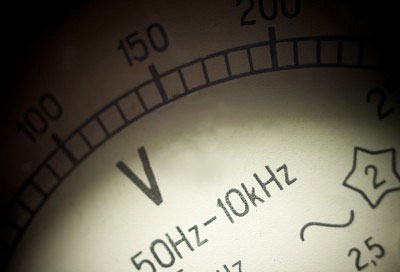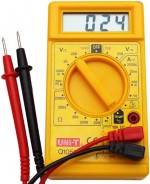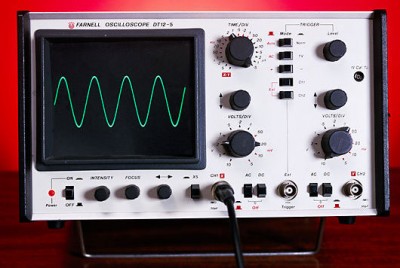
At a very basic level, synthesis is all about generating and manipulating voltages. Different parts of the synth are controlled by voltages. The audio signals themselves are voltages that change rapidly. But what exactly is voltage?
Voltage is a difference in electrical potential energy between two points. It represents electricity’s ability to do work. Water and plumbing analogies are often used when explaining electrical concepts; voltage is analogous to water pressure.
 Learn more about voltage at Wikipedia
Learn more about voltage at WikipediaYou don’t need to know a lot about electricity to operate a synthesizer, but understanding a few basic concepts will certainly help.
Voltage is specified by a certain number of “Volts” (labeled with a “V”). To give you an idea of the voltage levels we’re dealing with, here are a few common voltage sources you encounter in your everyday life and the number of volts they supply:
- AA Battery = 1.5V
- 9V Battery = 9V (duh)
- Car battery = 12V
- Household electrical outlet (in the U.S.) = 120V
Anything under 30V is generally considered safe to touch. Synthesizers usually operate on +/-15V or less, so it’s safe to touch patch cables even if there is a voltage present at the end.
Measuring Voltage
As stated above, voltage is a difference in potential between two points. You can’t just say that there is 5V on a terminal or connector. 5V relative to what? Normally all voltages in a synthesizer are given relative to chassis ground. This means that the metal parts of the case of the synth are considered to be 0V, and any voltage present in the system is relative to that.
 If you have a synth that uses phone jacks (3.5mm or 1/4″), you may notice that there are two contacts on each connector. The tip carries the voltage signal, and the sleeve is ground. All the sleeves of all the connectors are connected together and grounded.
If you have a synth that uses phone jacks (3.5mm or 1/4″), you may notice that there are two contacts on each connector. The tip carries the voltage signal, and the sleeve is ground. All the sleeves of all the connectors are connected together and grounded.
Some synths use a type of jack called a banana jack. These connectors only have one contact, so all the grounding in the system is done internally or through the chassis.
 To measure a voltage, you can use a voltmeter / multimeter. Turn the meter on and set it for DC Volts or AC Volts, depending on what you are trying to measure (see next section). The meter will have two probes; touch one probe (red / + / positive) to the point containing the voltage you want to measure, and the other (black / – / negative) probe to ground.
To measure a voltage, you can use a voltmeter / multimeter. Turn the meter on and set it for DC Volts or AC Volts, depending on what you are trying to measure (see next section). The meter will have two probes; touch one probe (red / + / positive) to the point containing the voltage you want to measure, and the other (black / – / negative) probe to ground.
Signals in a synthesizer aren’t always positive relative to ground. Sometimes they are negative, meaning that ground is more positive than they are. In fact, many synths are powered by a +/-15V power supply which provides both +15v and -15V to the system. That means between the + and – supplies there is a 30V potential.
DC vs. AC
There are two types of current electricity: DC and AC. DC stands for “Direct Current” and is a constant, steady voltage that never changes polarities (the positive connection will always be positive and the negative connection will always be negative). This is the same type of electricity that comes out of a battery. Control voltages in a synth are often DC.
AC stands for “Alternating Current”. The polarity of an AC signal constantly switches back and forth, usually many times in a single second. The AC power in your house has a frequency of 60Hz (in the U.S.), meaning that it goes from positive to negative and back to positive again 60 times every second. Audio signals in a synth are AC.
Since AC voltages change so fast, measuring them with a meter doesn’t tell the whole story. You can use an oscilloscope to get a snapshot of what the AC signal looks like.
The above picture shows an oscilloscope displaying an AC waveform. The horizontal axis of the display is time, and the vertical axis is voltage. The overall image shows you how the signal changes over time.
The waveform shown on the screen is called a sine wave. This is the same waveform as your household power. You can see that it starts off at 0V (relative to ground, of course) on the left, then rises up, then reverses direction at the top and starts going back down. Once it gets back to 0 it keeps going until it has swung all the way negative. At the negative peak it reverses direction again and starts to head back toward 0.
Why would we care what an AC waveform looks like? Because they all sound different when they are amplified and fed through a speaker, and getting different sounds is what synthesis is all about! In the next lesson we’re going to talk more about different waveforms.













Remember that voltage is not what is dangerous, amperage is. A million volt differential means nothing if the amperage is small enough. However, with enough amperage, even small voltages can be fatal.
see http://hypertextbook.com/facts/2000/JackHsu.shtml
This is true, and an excellent point. Current kills! The “safe to touch” figures you read are based on the typical resistance of a human being. The more resistance in a circuit, the less current flows for any given voltage (ohm’s law). It happens that people are resistive enough that batteries are generally pretty safe, household power will hurt but you’ll probably survive, and high voltage power lines will cause enough current to flow through you to kill you pretty quickly. It doesn’t mean that there aren’t instances where lower voltages will cause enough current to flow to harm you, so it always pays to be careful.